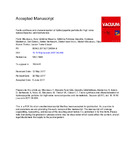JavaScript is disabled for your browser. Some features of this site may not work without it.
| dc.contributor.author | Miculescu, Florin | |
| dc.contributor.author | Mocanu, Aura-Cătălina | |
| dc.contributor.author | Dascălu, Cătălina Andreea | |
| dc.contributor.author | Maidaniuc, Andreea | |
| dc.contributor.author | Batalu, Dan | |
| dc.contributor.author | Berbecaru, Andrei | |
| dc.contributor.author | Voicu, Stefan Ioan | |
| dc.contributor.author | Miculescu, Marian | |
| dc.contributor.author | Kumar, Vijay | |
| dc.contributor.author | Ciocan, Lucian Toma | |
| dc.date.accessioned | 2017-06-15T11:24:08Z | |
| dc.date.available | 2017-06-15T11:24:08Z | |
| dc.date.issued | 2017-06-07 | |
| dc.identifier.citation | Florin Miculescu, Aura-Cătălina Mocanu, Cătălina Andreea Dascălu, Andreea Maidaniuc, Dan Batalu, Andrei Berbecaru, Stefan Ioan Voicu, Marian Miculescu, Vijay Kumar Thakur, Lucian Toma Ciocan, Facile synthesis and characterization of hydroxyapatite particles for high value nanocomposites and biomaterials, Vacuum, Available online 7 June 2017 | en_UK |
| dc.identifier.issn | 0042-207X | |
| dc.identifier.uri | http://dx.doi.org/10.1016/j.vacuum.2017.06.008 | |
| dc.identifier.uri | https://dspace.lib.cranfield.ac.uk/handle/1826/12029 | |
| dc.description.abstract | Lately Hydroxyapatite has gained a lot of research interest and intense focus due to its structural as well as compositional similarity to the components of human bone mineral. The conversion of calcium-rich precursors to hydroxyapatite could lead to the development of a new sustainable alternative with a valuable environmental and socio-economically impact. Still, current approaches faces lots of challenges in terms of synthesis parameters compatible to a reproducible route for calcium phosphates (hydroxyapatite included) synthesis. The optimization of Rathje synthesis route and characterization of biogenic derived calcium phosphates from dolomitic marble and Mytilus galloprovincialis seashells, constitutes the main goals of this study. The synthesized materials were characterized using FTIR, SEM coupled with EDS, and X-ray diffraction at all synthesis stages. Precursors were also subjected to thermal analysis and differential scanning calorimetry for thermal transformations investigations and dissociation temperature setting. This study suggests that acid quantity and magnetic stirring are the key-factors for Ca/P molar ratio adjustment, hence for the amount of naturally-derived hydroxyapatite. This research also contributes to the development of new strategies for further optimization of the conversion procedure and removal of residual components. | en_UK |
| dc.language.iso | en | en_UK |
| dc.publisher | Elsevier | en_UK |
| dc.rights | Attribution-NonCommercial-NoDerivatives 4.0 International | |
| dc.rights.uri | http://creativecommons.org/licenses/by-nc-nd/4.0/ | |
| dc.subject | Dolomitic marble and Mytilus galloprovincialis seashell | en_UK |
| dc.subject | Hydroxyapatite chemical precipitation | en_UK |
| dc.subject | Ca/P molar ratio | en_UK |
| dc.subject | Hydroxyapatite phase-proportion | en_UK |
| dc.subject | Bi-phasic calcium phosphate | en_UK |
| dc.title | Facile synthesis and characterization of hydroxyapatite particles for high value nanocomposites and biomaterials | en_UK |
| dc.type | Article | en_UK |
Files in this item
This item appears in the following Collection(s)
-
Staff publications (SATM) [4367]

